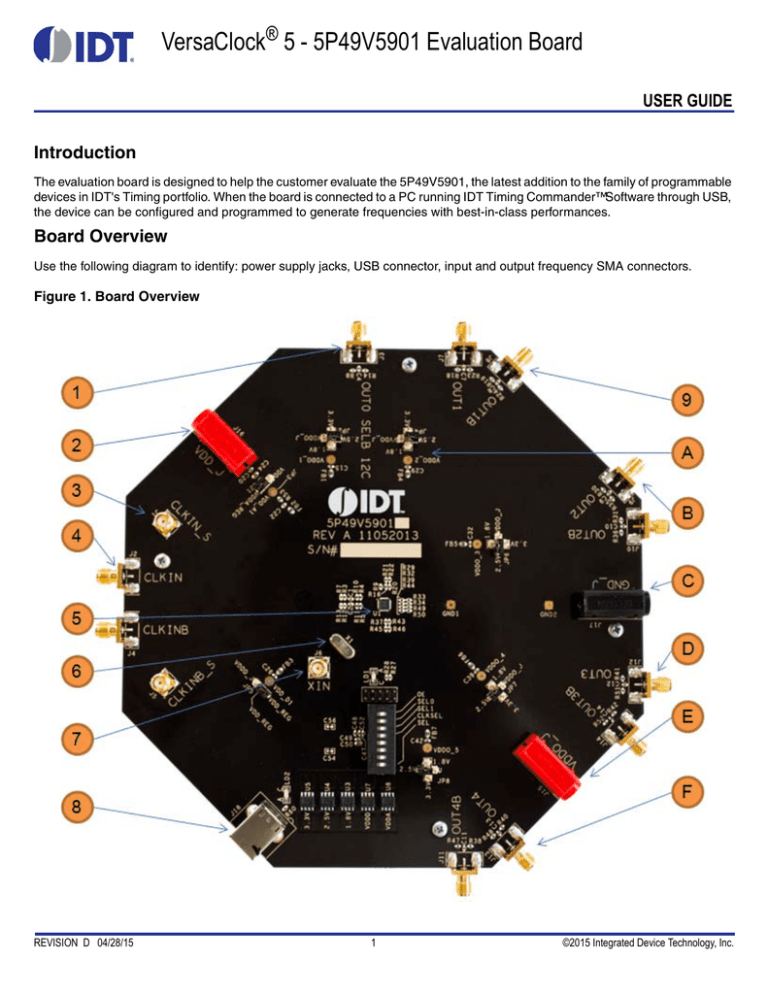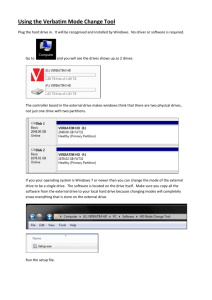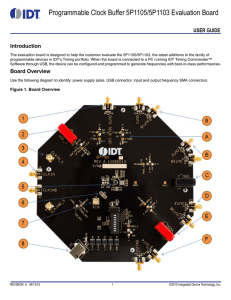
VersaClock® 5 - 5P49V5901 Evaluation Board
USER GUIDE
Introduction
The evaluation board is designed to help the customer evaluate the 5P49V5901, the latest addition to the family of programmable
devices in IDT's Timing portfolio. When the board is connected to a PC running IDT Timing Commander™Software through USB,
the device can be configured and programmed to generate frequencies with best-in-class performances.
Board Overview
Use the following diagram to identify: power supply jacks, USB connector, input and output frequency SMA connectors.
Figure 1. Board Overview
REVISION D 04/28/15
1
©2015 Integrated Device Technology, Inc.
VERSACLOCK® 5 - 5P49V5901 Evaluation Board
1
OUT0 - This is a buffered output of the input reference clock, singled ended.
2
Power supply jack, J16 – Connect to 3.3V, 2.5V or 1.8V for the core voltage of the device.
3
CLKIN_S/CLKINB_S – SMA pair used to monitor the differential input CLKIN/CLKINB.
4
Differential Input clock connector – A differential clock can be connected as a source for the device.
5
5P49V5901 – the device to be evaluated.
6
Crystal – On-board crystal, 25MHz. There are two package holders for crystals: one through-hold and a surface-mount
(3225) on the bottom layer of the board.
7
XIN connector – This SMA connector is for single-ended clock input. Please note the full swing of this input is 1.2V
maximum.
8
USB connector – Used this connector to connect with your PC to run IDT Timing Commander Software.
9
OUT1 /OUT1B – Output 1. It can be a differential pair or two individual single-ended outputs. By default, it's an LVPECL
differential output.
A
Output voltage selector – 4-way header to select an output voltage. The center pin is the output voltage. Use the jumper
to select from 1.8V, 2.5V or 3.3V. VDDO_J is the voltage from J15 (see E).
B
OUT2/OUT2B – Output 2. It can be a differential pair or two individual single-ended outputs. By default, it's an LVPECL
differential output.
C
Ground Jack – J17. If J15 and/or J16 is used for power supply, this jack is the power return.
D
OUT3/OUT3B – Output 3. It can be a differential pair or two individual single-ended outputs. By default, it's an LVPECL
differential output.
E
Output Voltage Jack – J15. Connect to a voltage of 1.8V, 2.5V or 3.3V for output voltages.
F
OUT4/OUT4B – Output 4. It can be a differential pair or two individual single-ended outputs. By default, it's an LVPECL
differential output.
Board Power Supply
• Core Voltages
The core voltage includes a digital voltage VDDD and an analog voltage VDDA. Both core voltages can be powered by an
external bench power supply or by USB.
Bench Power Supply – To supply VDDD with a bench power supply, connect power to J16. To supply VDDA with a bench power
supply, connect power to J15. In the same time, place the jumpers in JP3 and JP5 to connect VDDA_J and VDDD_J, respectively.
USB Power Supply – When the board is connected to a PC through a USB cable, on-board voltage regulators will generate a
3.3V for the device. In this case, place the jumpers in JP3 and JP5 to connect VDDA_REG and VDDD_REG, respectively. See
JP5 jumper position for VDDD_REG in the following figure. USB power source is recommended because it's readily available
right from your laptop.
2
REVISION D 04/28/15
VERSACLOCK® 5 - 5P49V5901 Evaluation Board
Figure 2. Jumping to the VDDD_J side will select external bench power supply; Jumping to the VDD_REG
side will select power source from on-board regulators powered by USB
• Output Clock Voltages
Like VDDA and VDDD having two sources, each output voltage VDDO0~4 is also provided with two sources to choose from:
bench power supply or powered from USB. The selection is made by a 4-way header as shown in Figure 3 below. Jumping to
VDDO_J will select external power supply (JP15 and JP16 are connected to external power supply); Jumping to 1.8V, 2.5V or
3.3V will select each respective voltage from on-board voltage regulators powered by USB port.
Please note: each output voltage can be individually selected. Use the label on the evaluation board: VDDO_1 for OUT0,
VDDO_2 for OUT1, VDDO_3 for OUT2, VDDO_4 for OUT3 and VDDO_5 for OUT4.
Figure 3. Use the jumper to select a voltage for OUT3: 1.8V/2.5V/3.3V is from on-board voltage regulators
powered by USB; VDDO_J is from external power supply connecting to JP15 and JP16
REVISION D 04/28/15
3
VERSACLOCK® 5 - 5P49V5901 Evaluation Board
Connecting the Board
The board is connected to a PC through a USB connector for configuring and programming the device, as shown in Figure 4
below. The USB interface will also provide +5V power supply to the board, from which on-board voltage regulators generate
various voltages for the core as well as for each output.
The board can also be powered by a bench power supply by connecting two banana jacks J15, J16 for output and core voltages,
respectively. Please see board power supply section for details.
Note: The USB port only supports USB 2.0; USB 3.0 is not supported at this time.
Figure 4. Connecting the Board with USB Port for Communications with Timing Commander Software
4
REVISION D 04/28/15
VERSACLOCK® 5 - 5P49V5901 Evaluation Board
On-Board Crystal
A 25MHz crystal is installed on the board. It can source a reference frequency to the device when CLKIN/CLKINB is not used.
The device can reference from either the crystal or an external clock source. Clock source can be selected within GUI software.
Other input reference can be supplied to CLKIN/CLKINB (differential) or XIN (LVCMOS with full swing of 1.2V) connectors.
Board Default Frequency Output
When 25MHz crystal is installed, the device will have two default outputs: OUT0 = 25MHz, OUT1 = 100MHz.
Configuration and Setup
Use the following steps to setup the board using I2C and start the configuration of the board.
1. Set SEL pin (pin 8) of dip switch (U2) to "0" to select I2C mode.
2. Connect J18 to a USB port of the PC using the supplied I2C cable.
3. Power up the board.
4. Launch VC5 Timing Commander Software (refer to VC5 Timing Commander User Guide - Getting Started Step 1~7).
Following the Getting Started steps in the Timing Commander software, an I2C connection is established between the GUI
software and VC5 chip.
5. Load the setting file into the GUI and write the settings to the chip.
6. All intended outputs should be available for measurement.
Board Schematics
Evaluation board schematics are shown on the following pages.
REVISION D 04/28/15
5
VERSACLOCK® 5 - 5P49V5901 Evaluation Board
Figure 5. VersaClock 5 Evaluation Board Schematics – Page 1
6
REVISION D 04/28/15
VERSACLOCK® 5 - 5P49V5901 Evaluation Board
Figure 6. VersaClock 5 Evaluation Board Schematics – Page 2
REVISION D 04/28/15
7
VERSACLOCK® 5 - 5P49V5901 Evaluation Board
Figure 7. Evaluation Board Schematics – Page 3
8
REVISION D 04/28/15
VERSACLOCK® 5 - 5P49V5901 Evaluation Board
Signal Termination Options
Termination options for OUTPUT1 – 4 in the evaluation board are displayed in Figure 8. The termination circuits are designed to
optionally terminate the output clocks in LVPECL, LVDS, LVCMOS and HCSL signal types by populating (or not-populating)
some resistors. DC or AC coupling of these outputs are also supported.
Tables1 – 4, below, tabulates component installations to support LVPECL, HCSL, LVCMOS and LVDS signal types for OUTPUT1
– 4, respectively. Please note that by doing so, the output signals will be measured and terminated by an oscilloscope with a 50
internal termination.
Figure 8. Output Termination Options
Table 1. Termination Options for OUTPUT1
Signal Type
Series Resistors:
R16, R20
180-ohm pull-down:
R21, R22
Series Capacitor:
C7, C8
Resistor Network:
R18, R19, R23, R24
LVPECL
0
Installed
0.1 µF
Not installed
HCSL
33
Not installed
0
Not installed
LVCMOS
33
Not installed
0.1 µF
Not installed
LVDS
0
Not installed
0.1 µF
Not installed
REVISION D 04/28/15
9
VERSACLOCK® 5 - 5P49V5901 Evaluation Board
Table 2. Termination Options for OUTPUT2
Signal Type
Series Resistors:
R29, R32
180-ohm pull-down:
R49, R50
Series Capacitor:
C9, C10
Resistor Network:
R30, R31, R35, R36
LVPECL
0
Installed
0.1 µF
Not installed
HCSL
33
Not installed
0
Not installed
LVCMOS
33
Not installed
0.1 µF
Not installed
LVDS
0
Not installed
0.1 µF
Not installed
Table 3. Termination Options for OUTPUT3
Signal Type
Series Resistors:
R39, R44
180-ohm pull-down:
R21, R22
Series Capacitor:
C12, C14
Resistor Network:
R41, R42, R51, R52
LVPECL
0
Installed
0.1 µF
Not installed
HCSL
33
Not installed
0
Not installed
LVCMOS
33
Not installed
0.1 µF
Not installed
LVDS
0
Not installed
0.1 µF
Not installed
Table 4. Termination Options for OUTPUT4
Signal Type
Series Resistors:
R37, R43
180-ohm pull-down:
R45, R46
Series Capacitor:
C11, C13
Resistor Network:
R38, R40, R47, R48
LVPECL
0
Installed
0.1 µF
Not installed
HCSL
33
Not installed
0
Not installed
LVCMOS
33
Not installed
0.1 µF
Not installed
LVDS
0
Not installed
0.1 µF
Not installed
As noted, 4-resistor network is not installed in Table-1 – 4 because oscilloscope with internal 50 termination is utilized for signal
termination and measurement. If an AC-coupled, stand-alone LVPECL output is needed (without oscilloscope connections), the
4-resistor network needs to be installed accordingly.
Table 5. Resistor Network Termination for LVPECL for OUTPUT1
Signal Type
Series Resistors:
R37, R43
180-ohm pull-down:
R45, R46
Series Capacitor:
C11, C13
Resistor Network:
R18, R19, R23, R24
LVPECL
0
Installed
0.1 µF
R18 = R19 = 125
R23 = R24 = 84
10
REVISION D 04/28/15
VERSACLOCK® 5 - 5P49V5901 Evaluation Board
Orderable Part Numbers
The following evaluation board part numbers are available for order.
Table 6. Orderable Part Numbers
Part Number
Description
EVKVC5-5901HCSL
Evaluation board with all outputs terminated as HCSL
EVKVC55901LPECL
Evaluation board with all outputs terminated as LVPECL
EVKVC5-5901LVDS
Evaluation board with all outputs terminated as LVDS
EVKVC55901LCMOS
Evaluation board with all outputs terminated as LVCMOS
EVKVC5-5901ALL
Evaluation board with one output of each type of signal terminations
REVISION D 04/28/15
11
Corporate Headquarters
Sales
Tech Support
6024 Silver Creek Valley Road
San Jose, CA 95138 USA
1-800-345-7015 or
408-284-8200
Fax: 408-284-2775
www.IDT.com
email: clocks@idt.com
480-763-2056
DISCLAIMER Integrated Device Technology, Inc. (IDT) and its subsidiaries reserve the right to modify the products and/or specifications described herein at any time and at IDT’s sole discretion. All information in
this document, including descriptions of product features and performance, is subject to change without notice. Performance specifications and the operating parameters of the described products are determined
in the independent state and are not guaranteed to perform the same way when installed in customer products. The information contained herein is provided without representation or warranty of any kind, whether
express or implied, including, but not limited to, the suitability of IDT’s products for any particular purpose, an implied warranty of merchantability, or non-infringement of the intellectual property rights of others. This
document is presented only as a guide and does not convey any license under intellectual property rights of IDT or any third parties.
IDT’s products are not intended for use in applications involving extreme environmental conditions or in life support systems or similar devices where the failure or malfunction of an IDT product can be reasonably
expected to significantly affect the health or safety of users. Anyone using an IDT product in such a manner does so at their own risk, absent an express, written agreement by IDT.
Integrated Device Technology, IDT and the IDT logo are registered trademarks of IDT. Product specification subject to change without notice. Other trademarks and service marks used herein, including protected
names, logos and designs, are the property of IDT or their respective third party owners.
Copyright ©2015 Integrated Device Technology, Inc.. All rights reserved.






